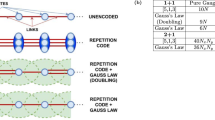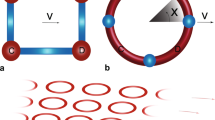Abstract
Circuits can provide a platform to study novel physics and have been used, for example, to explore various topological phases. Gauge fields—particularly, non-Abelian gauge fields—can play a pivotal role in the design and modulation of novel physical states, but their circuit implementation has so far been limited. Here we show that non-Abelian gauge fields can be synthesized in circuits created from building blocks that consist of capacitors, inductors and resistors. With these building blocks, we create circuit designs for the spin–orbit interaction and the topological Chern state, which are phenomena that represent non-Abelian gauge fields in momentum space. We also use the approach to design non-reciprocal circuits that can be used to implement the non-Abelian Aharonov–Bohm effect in real space.
This is a preview of subscription content, access via your institution
Access options
Access Nature and 54 other Nature Portfolio journals
Get Nature+, our best-value online-access subscription
$29.99 / 30 days
cancel any time
Subscribe to this journal
Receive 12 digital issues and online access to articles
$119.00 per year
only $9.92 per issue
Buy this article
- Purchase on Springer Link
- Instant access to full article PDF
Prices may be subject to local taxes which are calculated during checkout





Similar content being viewed by others
Data availability
The data that support the findings of this study are available from the corresponding authors upon reasonable request.
Code availability
The codes that support the findings of this study are available from the corresponding authors upon reasonable request.
References
Osterloh, K., Baig, M., Santos, L., Zoller, P. & Lewenstein, M. Cold atoms in non-Abelian gauge potentials: from the Hofstadter ‘moth’ to lattice gauge theory. Phys. Rev. Lett. 95, 010403 (2005).
Lin, Y.-J., Jiménez-García, K. & Spielman, I. B. Spin–orbit-coupled Bose–Einstein condensates. Nature 471, 83–86 (2011).
Huang, L. et al. Experimental realization of two-dimensional synthetic spin–orbit coupling in ultracold Fermi gases. Nat. Phys. 12, 540–544 (2016).
Wu, Z. et al. Realization of two-dimensional spin-orbit coupling for Bose-Einstein condensates. Science 354, 83–88 (2016).
Cooper, N. R., Dalibard, J. & Spielman, I. B. Topological bands for ultracold atoms. Rev. Mod. Phys. 91, 015005 (2019).
Terças, H., Flayac, H., Solnyshkov, D. D. & Malpuech, G. Non-Abelian gauge fields in photonic cavities and photonic superfluids. Phys. Rev. Lett. 112, 066402 (2014).
Iadecola, T., Schuster, T. & Chamon, C. Non-Abelian braiding of light. Phys. Rev. Lett. 117, 073901 (2016).
Chen, Y. et al. Non-Abelian gauge field optics. Nat. Commun. 10, 3125 (2019).
Rechcińska, K. et al. Engineering spin-orbit synthetic Hamiltonians in liquid-crystal optical cavities. Science 366, 727–730 (2019).
Yang, Y. et al. Synthesis and observation of non-Abelian gauge fields in real space. Science 365, 1021–1025 (2019).
Ozawa, T. et al. Topological photonics. Rev. Mod. Phys. 91, 015006 (2019).
Whittaker, C. E. et al. Optical analogue of Dresselhaus spin–orbit interaction in photonic graphene. Nat. Photon. 15, 193–196 (2021).
Lim, H.-T., Togan, E., Kroner, M., Miguel-Sanchez, J. & Imamoglu, A. Electrically tunable artificial gauge potential for polaritons. Nat. Commun. 8, 14540 (2017).
Fruchart, M., Zhou, Y. & Vitelli, V. Dualities and non-Abelian mechanics. Nature 577, 636–640 (2020).
Jotzu, G. et al. Experimental realization of the topological Haldane model with ultracold fermions. Nature 515, 237–240 (2014).
Sugawa, S., Salces-Carcoba, F., Perry, A. R., Yue, Y. & Spielman, I. B. Second Chern number of a quantum-simulated non-Abelian Yang monopole. Science 360, 1429–1434 (2018).
Wu, Q., Soluyanov, A. A. & Bzdusek, T. Non-Abelian band topology in noninteracting metals. Science 365, 1273–1277 (2019).
Mezzacapo, A. et al. Non-Abelian SU(2) lattice gauge theories in superconducting circuits. Phys. Rev. Lett. 115, 240502 (2015).
Ningyuan, J., Owens, C., Sommer, A., Schuster, D. & Simon, J. Time- and site-resolved dynamics in a topological circuit. Phys. Rev. X 5, 021031 (2015).
Albert, V. V., Glazman, L. I. & Jiang, L. Topological properties of linear circuit lattices. Phys. Rev. Lett. 114, 173902 (2015).
Lee, C. H. et al. Topolectrical circuits. Commun. Phys. 1, 39 (2018).
Luo, K., Yu, R. & Weng, H. Topological nodal states in circuit lattice. Research 2018, 6793752 (2018).
Zhao, E. Topological circuits of inductors and capacitors. Ann. Phys. 399, 289–313 (2018).
Lu, Y. et al. Probing the Berry curvature and Fermi arcs of a Weyl circuit. Phys. Rev. B 99, 020302 (2019).
Hofmann, T., Helbig, T., Lee, C. H., Greiter, M. & Thomale, R. Chiral voltage propagation and calibration in a topolectrical Chern circuit. Phys. Rev. Lett. 122, 247702 (2019).
Haenel, R., Branch, T. & Franz, M. Chern insulators for electromagnetic waves in electrical circuit networks. Phys. Rev. B 99, 235110 (2019).
Imhof, S. et al. Topolectrical-circuit realization of topological corner modes. Nat. Phys. 14, 925–929 (2018).
Ezawa, M. Higher-order topological electric circuits and topological corner resonance on the breathing kagome and pyrochlore lattices. Phys. Rev. B 98, 201402 (2018).
Bao, J. et al. Topoelectrical circuit octupole insulator with topologically protected corner states. Phys. Rev. B 100, 201406 (2019).
Serra-Garcia, M., Süsstrunk, R. & Huber, S. D. Observation of quadrupole transitions and edge mode topology in an LC circuit network. Phys. Rev. B 99, 020304 (2019).
Ni, X., Xiao, Z., Khanikaev, A. B. & Alù, A. Robust multiplexing with topolectrical higher-order Chern insulators. Phys. Rev. Appl. 13, 064031 (2020).
Yu, R., Zhao, Y. X. & Schnyder, A. P. 4D spinless topological insulator in a periodic electric circuit. Natl Sci. Rev. 7, 1288–1295 (2020).
Wang, Y., Price, H. M., Zhang, B. & Chong, Y. D. Circuit implementation of a four-dimensional topological insulator. Nat. Commun. 11, 2356 (2020).
Yang, C. N. & Mills, R. L. Conservation of isotopic spin and isotopic gauge invariance. Phys. Rev. 96, 191–195 (1954).
Bychkov, Y. A. & Rashba, É. I. Properties of a 2D electron gas with lifted spectral degeneracy. JETP Lett. 39, 78 (1984).
Dresselhaus, G. Spin-orbit coupling effects in zinc blende structures. Phys. Rev. 100, 580–586 (1955).
Özdemir, Ş. K., Rotter, S., Nori, F. & Yang, L. Parity-time symmetry and exceptional points in photonics. Nat. Mater. 18, 783–798 (2019).
Rafi-Ul-Islam, S. M., Siu, Z. B. & Jalil, M. B. A. Non-Hermitian topological phases and exceptional lines in topolectrical circuits. New J. Phys. 23, 033014 (2021).
Xiao, D., Chang, M.-C. & Niu, Q. Berry phase effects on electronic properties. Rev. Mod. Phys. 82, 1959–2007 (2010).
Acknowledgements
We thank H. M. Weng, C. Fang, D. Zhang, H. Wang and S. Chang for valuable discussions. R.Y. acknowledges support from the National Key Research and Development Program of China (nos. 2017YFA0304700 and 2017YFA0303402), the National Natural Science Foundation of China (no. 11874048) and the Beijing National Laboratory for Condensed Matter Physics. F.S. acknowledges support from the National Natural Science Foundation of China (nos. 92161201, 12025404, 11904165 and 11904166).
Author information
Authors and Affiliations
Contributions
R.Y. supervised the project. J.W., Z.W. and R.Y. drew the circuit diagram of the SOI PCB. Z.W. and R.Y. measured the experimental data of the SOI circuit. Z.Y., Y.H. and R.Y. drew the circuit diagram of the Chern PCB. Z.W., T.W., Z.Y., Y.H. and Z.S. measured the experimental data of the Chern circuit. Z.W., Y.B., S.Z. and F.F. measured the experimental data of the non-Abelian Aharonov–Bohm effect. J.W. wrote part of the data acquisition program for the experimental instruments. F.S. and R.Y. analysed the data.
Corresponding authors
Ethics declarations
Competing interests
The authors declare no competing interests.
Peer review
Peer review information
Nature Electronics thanks Biao Yang and the other, anonymous, reviewer(s) for their contribution to the peer review of this work.
Additional information
Publisher’s note Springer Nature remains neutral with regard to jurisdictional claims in published maps and institutional affiliations.
Supplementary information
Supplementary Information
Supplementary Figs. 1–6, Sections 1–4 and Tables 1 and 2.
Rights and permissions
Springer Nature or its licensor holds exclusive rights to this article under a publishing agreement with the author(s) or other rightsholder(s); author self-archiving of the accepted manuscript version of this article is solely governed by the terms of such publishing agreement and applicable law.
About this article
Cite this article
Wu, J., Wang, Z., Biao, Y. et al. Non-Abelian gauge fields in circuit systems. Nat Electron 5, 635–642 (2022). https://doi.org/10.1038/s41928-022-00833-8
Received:
Accepted:
Published:
Issue Date:
DOI: https://doi.org/10.1038/s41928-022-00833-8
This article is cited by
-
Quantum transports in two-dimensions with long range hopping
Scientific Reports (2023)
-
Realization of Wilson fermions in topolectrical circuits
Communications Physics (2023)



